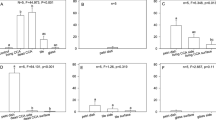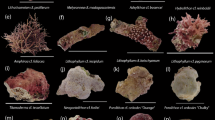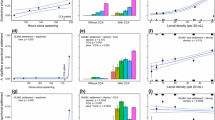Abstract
The rate at which larvae successfully recruit into communities of marine benthic invertebrates is partially dependent upon how well larvae avoid benthic predators and settle on appropriate substrata. Therefore, to be able to predict recruitment success, information is needed on how larvae search for settlement sites, whether larvae preferentially settle on certain substrata, and the extent to which there are adequate cues for larvae to find these substrata. This article describes how larvae of the colonial ascidian Diplosoma similis find settlement sites on a coral reef. Direct field observations of larval settlement were made on a fringing reef in Kaneohe Bay, Oahu, Hawaii, between September 1985 and April 1986. A comparison of the substrata that larvae contacted prior to settlement relative to the percentage cover of these substrata on the study reef suggests that larvae are using a non-contact mode of substratum identification to locate suitable settlement sites. This mode of substratum identification allowed 74% of larvae to evade predation by benthic organisms who would otherwise have eaten larvae if they had been contacted. Of those larvae that evaded predation, 88% subsequently settled on the same two substrata upon which most adults are found (dead coral or the green alga Dictyosphaeria cavernosa). This pattern of settlement was probably a result of active selection, since the two substrata cover only 14.4% of the reef's surface and currents had little effect on the direction in which larvae swam. An important contributing factor to the high success rate of larval settlement on suitable substrata was the lack of any temporal decay in substratum preference. It is concluded that for Diplosoma similis larval supply is a sufficient predictor of larval settlement rate. However, for marine invertebrates whose larvae are passively dispersed and exhibit a greater temporal decay in substratum preference, larval settlement should generally have a greater dependency on spatial variation in the abundance of benthic predators and suitable substrata.
Similar content being viewed by others
References
Bayne BL (1965) Growth and delay of metamoprhosis of the larvae of Mytilus edulis (L). Ophelia 2:1–47
Bingham BL, Young CM (1991) Larval behavior of the ascidian Ecteinascidia turbinata Herdman; an in situ experimental study of the effects of swimming on dispersal. J exp mar Biol Ecol 145:189–204
Buss LW (1979) Habitat selection, directional growth and spatial refuges: why colonial animals have more hiding places. In: Larwood G, Rosen BR (eds) Biology and systematics of colonial organisms. Academic Press, New York and London, pp 459–497
Butman CA (1987) Larval settlement of soft-sediment invertebrates: the spatial scales of pattern explained by active habitat choice and the emerging role of hydrodynamical processes. Oceanogr mar Biol A Rev 25:113–165
Carlon DB, Olson RR (1993) Larval dispersal distance as an explanation for adult spatial pattern in two Caribbean reef corals. J exp mar Biol Ecol 173:247–263
Chia FS, Buckland-Nicks J, Young CM (1984) Locomotion of marine larvae: a review. Can J Zool 62:1205–1222
Chia FS, Koss R (1988) Induction of settlement and metamorphosis of the veliger larvae of the nudibranch, Onchidoris bilamellata. Int J Invert Reprod Dev 14:53–70
Connell JH (1961) Effects of competition, predation by Thais lapillus, and other factors on natural populations of the barnacle Balanus balanoides. Ecol Mongr 31:61–104
Connell JH (1985) The consequences of variation in initial settlement vs. post-settlement mortality in rocky intertidal communitites. J exp mar Biol Ecol 93:11–45
Crisp DJ (1974) Factors influencing the settlement of marine invertebrate larvae: a review. In: Grant PT, Mackie AM (eds) Chemoreception in marine organisms. Academic Press, London, pp 177–277
Crisp DJ (1985) Recruitment of barnacle larvae from the plankton. Bull mar Sci 37:478–486
Crisp DJ, Meadows PS (1962) The chemical basis of gregariousness in cirripides. Proc R Soc (Ser B) 156:500–520
Davis AR (1987) Variation in recruitment of the subtidal colonial ascidian Podoclavella cylindrica (Quoy and Gaimard): the role of substratum choice and early survival. J exp mar Biol Ecol 106:57–71
Davis AR, Butler AJ, van Altena I (1991) Settlement behavior of ascidian larvae: preliminary evidence for inhibition by sponge allelochemicals. Mar Ecol Prog Ser 72:117–123
Doyle RW (1975) Settlement of planktonic larvae: a theory of habitat selection in varying environments. Am Nat 109:113–126
Fitt WK, Coon SL, Walch M, Weiner RM, Colwell RR, Bonar, DB (1990) Settlement behavior and metamorphosis of oyster larvae (Crassostrea gigas) in response to bacterial supernatants. Mar Biol 106:389–394
Gaines SD, Roughgarden, J (1985) Larval settlement rate: a leading determinant of structure in an ecological community of the marine intertidal zone. Proc natn Acad Sci USA 82:3707–3711
Grave C (1935) Metamorphosis of ascidian larvae. Pap Tortugas Lab 29:209–292
Hadfield MG (1984) Settlement requirements of molluscan larvae: new data on chemical and genetic roles. Aquaculture, Amsterdam 39:283–298
Keough MJ, Downes BJ (1982) Recruitment of marine invertebrates: the roles of active larval choices and early mortality. Oecologia 48:13–18
Knight-Jones EW (1953) Laboratory experiments on gregariousness during settling in Balanus balanoides and other barnacles. J exp Biol 30:584–598
Kott P (1980) Algal-bearing didemnid ascidians in the Indowest Pacific. Mem Qd Mus 20:1–47
Meadows PS, Campbell JI (1972) Habitat selection by aquatic invertebrates. Adv mar Biol 10:271–382
Menge BA, Sutherland JP (1987) Community regulation: variation in disturbance, competition and predation in relation to environmental stress and recruitment. Am Nat 130:730–757
Mileikovsky SA (1974) On predation of pelagic larvae and early juveniles of marine bottom invertebrates by adult benthic invertebrates and their passing alive through their predators. Mar Biol 26:303–311
Morse DE (1990) Recent progress in larval settlement and metamorphosis: closing the gaps between molecular biology and ecology. Bull mar Sci 46:465–483
Olson RR (1985) The consequences of short-distance larval dispersal in a sessile marine invertebrate. Ecology 66:30–39
Pawlik JR (1992) Chemical ecology of the settlement of benthic marine invertebrates. Oceanogr A Rev mar Biol 30: 273–335
Raimondi PT, Keough MJ (1990) Behavioral variability in marine larvae. Aust J Ecol 15:427–437
Ritschoff DJ, Maki J, Mitchell R, Costlow JD (1986) Ion and neuropharmalogical studies of barnacle settlement. Neth J Sea Res 20:269–275
Roughgarden J, Iwasa Y, Baxter C (1985) Demographic theory for an open marine population with space-limited recruitment. Ecology 66:54–67
Sammarco PW, Andrews JC (1988) Localized dispersal and recruitment in Great Barrier Reef corals: the Helix experiment. Science, NY 239:1422–1424
Sears MA, Gerhart DJ, Rittschof D (1990) Antifouling agents from marine sponge Lissodendoryx isodictyalis Carter. J chem Ecol 16:791–803
Sokal RR, Rohlf FJ (1981) Biometry. The principles and practice of statistics in biological research. 2nd edn. WH Freeman & Co., New York
Stoner DS (1990) Recruitment of a tropical colonial ascidian: relative importance of pre-settlement vs. post-settlement processes. Ecology 71:1682–1690
Stoner DS (1992) Vertical distribution of a colonial ascidian on a coral reef: the roles of larval dispersal and life-history variation. Am Nat 139:802–834
Strathmann RR (1985) Feeding and nonfeeding larval development and life-history evolution in marine invertebrates. Ann Rev Ecol Syst 16:339–361
Strathmann RR, Branscomb ES, Vedder K (1981) Fatal errors in set as a cost of dispersal and the influence of intertidal flora on set of barnacles. Oecologia 48:13–18
Sutherland JP (1974) Multiple stable points in natural communities. Am Nat 108:859–873
Svane I, Havenhand JN, Jørgensen AJ (1987) Effects of tissue extracts of adults on metamorphosis in Ascidia mentula O. F. Müller and Ascidiella scabra (O. F. Müller). J exp mar Biol Ecol 110:171–181
Svane I, Young CM (1989) The ecology and behavior of ascidian larvae. Oceanogr mar Biol A Rev 27:45–90
Tamburri MN, Zimmer-Faust RK, Tamplin ML (1992) Natural sources and properties of chemical inducers mediating settlement of oyster larvae: a re-examination. Biol Bull mar biol Lab, Woods Hole 183:327–338
Thorson G (1950) Reproductive and larval ecology of marine bottom invertebrates. Biol Rev 25:1–45
Torrence SA, Cloney RA (1983) Ascidian larval nervous system: primary sensory neurons in adhesive papillae. Zoomorphology 102:111–123
Underwood AJ, Fairweather PG (1991) Supply-side ecology and benthic marine assemblages. Trends Ecol Evol 4:16–20
Walters LJ (1992) Post-settlement success of the arborescent bryozoan Bugula neritina (L.): the importance of structural complexity. J exp mar Biol Ecol 164:55–71
Wethey DS (1984) Spatial pattern in barnacle settlement: day to day changes during the settlement season. J mar biol Ass UK 64:687–698
Woodin SA (1976) Adult-larval interactions in dense infaunal assemblages: patterns of abundance. J mar Res 34:25–41
Young CM (1986) Direct observations of field swimming behavior in larvae of the colonial ascidian Ecteinascidia turbinata. Bull mar Sci 39:279–289
Young CM, Cameron JL (1989) Differential predation by barnacles upon larvae of two bryozoans: spatial effects at small scales. J exp mar biol Ecol 128:283–294
Young CM, Chia FS (1981) Laboratory evidence for delay of larval settlement in response to a dominant competitor. Int J Invert Reprod 3:221–226
Young CM, Chia FS (1984) Microhabitat-associated variability in survival and growth of subtidal solitary ascidians during the first 21 days after settlement. Mar Biol 81:61–68
Young CM, Chia FS (1987) Abunaance and distribution of pelagic larvae as influenced by predation, behavior, and hydrographic features. In: Giese AC, Pearse JS, Pearse VB (eds) Reproduction in marine invertebrates. Vol 9, Blackwell Scientific, Palo Alto, California, pp 385–463
Author information
Authors and Affiliations
Additional information
Communicated by M. F. Strathmann, Friday Harbor
Rights and permissions
About this article
Cite this article
Stoner, D.S. Larvae of a colonial ascidian use a non-contact mode of substratum selection on a coral reef. Marine Biology 121, 319–326 (1994). https://doi.org/10.1007/BF00346740
Received:
Accepted:
Issue Date:
DOI: https://doi.org/10.1007/BF00346740




